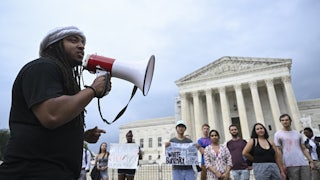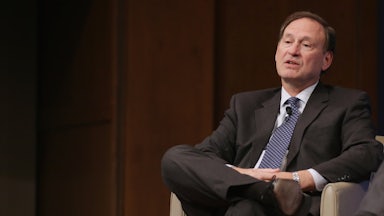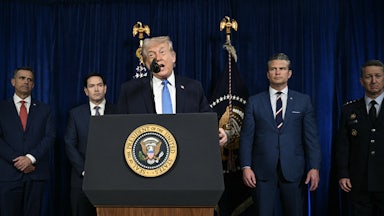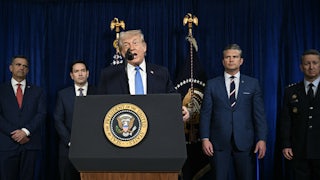On October 2, when the Supreme Court hosts its first oral argument of the 2023–24 term, members of its right-wing 6–3 supermajority will be in the spotlight and on the spot. One question in particular will rivet attention on all sides: During the previous term, the court registered something of an unexpected turn toward the center—a move that was partial and inconsistent but still startling to foes and fans alike. We look to this term to see whether this presages an enduring shift in direction or merely a one-off feint—staged to mute surging criticism, shrinking public approval ratings, and widespread demands for an enforceable Supreme Court code of ethical conduct.
To rehash last term’s surprises: In significant cases, between two and four justices among the right-wing bloc broke ranks. This led to some outcomes that eluded prognostications. Over the course of that term, the justices rebuffed right-wing activists’ invitations to emasculate long-standing voting safeguards, refusing to gut fundamental provisions of the 1965 Voting Rights Act and to embrace an anti-democratic doctrinal theory that could have empowered state legislatures, not voters, to dictate election results. The justices similarly rejected a radical concept that would have materially furthered a reactionary project touted by all six of the justices on the right—dismantling the federal “administrative state”—by dismissing a suit aimed at eliminating Congress’s authority to tie regulatory strings to federal funding grants.
Elsewhere, they also substantially cut back on widely criticized abuse of the court’s emergency procedures, known now as its “shadow docket,” to engineer stealth but far-reaching, nakedly partisan changes in substantive law. They slapped down instances of forum-shopping for notoriously partisan, right-wing lower court judges, by rejecting four of six appeals from the right-leaning Fifth Circuit Court of Appeals.
And even certain high-profile victories for the right ended up being substantially tamed, the most notable example being the court’s decision on barring affirmative action in university admissions, which came with a proviso that could retain or even expand opportunities for Black, brown, and other disadvantaged college applicants.
Importantly, however, Justices Brett Kavanaugh, Amy Coney Barrett, Neil Gorsuch, and Samuel Alito, and Chief Justice John Roberts hedged their support for some of these surprisingly liberal results, in ways that could foster a return to their pre-2022 hard-right form. To bar against this possibility, liberal leaders, especially liberal political leaders, need to stick with what’s been working and keep up the lines of attack—transparent partisanship, blatant disregard for precedent, legal text, and infidelity to Framers’ “original” design—that seem to have dented the right-wing majority’s lockstep cohesion.
Already, on September 25, one week before the new term’s formal start date, the court acted—favorably—on a preliminary test of whether conservative about-facers will stick to their guns this time around. On September 11, Alabama’s attorney general filed an emergency application, in effect asking the court to renege on its emphatic 5–4 affirmance of a district court’s order commanding the Alabama legislature to rewrite its congressional districting map, and create two districts likely to elect African American representatives, rather than just one, as the legislature had originally prescribed. The legislature defied the Supreme Court’s instruction and went back for another bite at the apple.
Alabama had hoped to flip Justice Kavanaugh’s vote, evidently based on a cryptic line at the end of his concurring opinion, that “the authority to conduct race-based redistricting cannot extend indefinitely into the future. Alabama did not raise that temporal argument in this Court, and I therefore would not consider it at this time.” But on September 26, Kavanaugh did not take the bait, as the court, without comment, denied Alabama’s application to reverse the district court’s “two majority-minority districts” diktat. Two other Southern states, Georgia and Louisiana, were watching Alabama’s effort at foot-dragging, to see if they might keep their own illegal districting maps in place through the 2024 election. Hence the Supreme Court’s reaffirmance could help turn at least three red seats blue.
Naturally, reaffirmance of a recent decision in the same case is typically a routine outcome. But this particular instance is a good—or at least a not bad—omen, however small. It reinforces the court’s last-term surprise decision, Allen v. Milligan, as a solid Roberts court precedent. That precedent includes Roberts’s remarkable affirmation of the VRA’s “stringent new remedies attempting to forever banish the blight of racial discrimination in voting … involv[ing] a quintessentially race-conscious calculus.” And as a matter of process, the reaffirmance marks rejection of a red-state activist attorney general’s bid to redeploy the high court’s once-favored stratagem of manipulating its shadow docket to advance partisan Republican interests.
In the new term, the formal “merits” docket will provide an early further test of that epochal ruling. On Wednesday, October 11, the court will host oral argument in a case, Alexander v. South Carolina State Conference of the NAACP, in which Republican South Carolina state legislators seek to overturn decades-old Supreme Court precedent establishing that state legislators commit “racial gerrymandering,” outlawed by the Fourteenth and Fifteenth Amendments, when their “predominant” criterion for drawing a districting map is race, even if their overall aims are “political,” not “racial.” Until the court’s Milligan shocker, South Carolina’s Republican legislators had good reason to expect a Supreme Court majority to walk that standard back. Now the question is whether the justices will walk back their own four-month-old ruling. The court’s September 25 rebuff of Alabama’s attempted second bite probably augurs disappointment for South Carolina’s hopes.
Even sooner, next Tuesday, October 3, a widely anticipated oral argument will preview the right’s willingness to continue pursuit of grandiose theories to “dismantle” doctrinal foundations of the “administrative state”—to logical endpoints catastrophic for traditionally Democrat-leaning middle- and working-class constituencies and the entire economy. This case, Consumer Financial Protection Bureau v. Community Financial Services Association, will air a claim that recent rightward doctrinal shifts require holding that the entire structure of the Consumer Financial Protection Bureau, or CFPB, is unconstitutional, because it gets its revenue from a specified chunk of the Federal Reserve system’s funds rather than annual congressional appropriations.
Granting that claim would precipitate legal and real-world earthquakes: It would invalidate literally thousands of agency decisions involving many billions of dollars or benefits to both consumers and financial providers, provoke legal challenges to the many federal agencies not funded by congressional appropriations, and potentially spark finance-sector upheavals capable of pushing the economy into recession, as The New Republic’s Matt Ford has elaborated.
Such cataclysmic outcomes cannot be dismissed as entirely implausible. The gutting of regulatory protections for workers, consumers, and the environment has long been a priority of the interests financing the conservative legal movement—much more so than the higher-profile issues that motivate culturally conservative voters. Most of the cases from last term in which some conservative justices proved willing to give ground were in the latter category. Such priorities were on full display in the court’s recent radically atextual decisions slashing the Environmental Protection Agency’s Clean Air Act authority to combat global warming, in June 2022, and its Clean Water Act authority to regulate wetlands, in May 2023.
This term could reveal how far the right-wing justices’ fidelity to these funders’ priorities will reach. To keep the justices’ feet to the fire, liberal leaders should keep busy messaging, before and after Monday’s oral argument, about those potentially catastrophic consequences; the baldly atextual, anti-originalist basis for their legal claims; the moneyed interests supporting them; and the self-indulgent cozying up to those interests flaunted by Justices Thomas and Alito.
Given such unhelpful fallout, and the unsavory repute of the payday-lender claimants, enough conservative justices may well break ranks to dismiss this bid to incinerate the CFPB, or at least sidestep it.
There is a second, much-ballyhooed assault against the “administrative state” on the docket that is likely to be argued early next year. This case, Loper Bright Enterprises v. Raimando, was accepted in May of this year solely to address one question: whether the court should overrule a 1984 decision widely known simply as “Chevron.” Chevron established a rule that federal judges and justices should “defer to”—which is lawyer-speak for “leave undisturbed”—“reasonable” agency interpretations of statutory provisions assigned to them in statutes, rather than craft the judges’ own interpretations.
As noted in an amicus curiae brief filed by Columbia Law administrative law guru Thomas Merrill, “Chevron is one of the most cited decisions in American public law,” 244 times by the Supreme Court itself and thousands of times by the lower federal courts and even state courts. The case, and the doctrine of “deference” to agency determinations for which it stands, have come to be reviled by anti-regulatory interests, activists, and academics. Texas firebrand Senator Ted Cruz, who filed an amicus brief in the case, denounced Chevron for “play[ing] an enormous role in the expansion of the administrative state … resulting in the American people being subject to the tyranny of the bureaucracy.”
No fewer than 53 conservative and libertarian think tanks, corporations, trade associations, and individuals filed amicus briefs calling for overrule of Chevron, sprinkled with similarly strident flourishes. On the left, the stakes in Loper were likewise histrionically cast in existential terms. In a brief on behalf of Senators Sheldon Whitehouse, Mazie Hirono, the late Dianne Feinstein, and Elizabeth Warren, University of California at Berkeley law Dean Erwin Chemerinsky urged the justices to “reject a decades-long effort by pro-corporate interests to eviscerate the federal government’s regulatory apparatus.” The senators’ accompanying press release warned that, “by overruling Chevron,” the court would “open the floodgates to corporate and judicial supremacy in our political system.”
Chemerinsky and his clients are certainly correct about their adversaries’ radically reactionary goals. But in truth, both sides overstate the impact this case is likely to have on the law or on the ground. The main reason for this forecast is that the court has already scaled back the applicability of Chevron, about as much as it is practically feasible to do. This retrenchment occurred principally in a 2015 decision, King v. Burwell.
In that case, Chief Justice Roberts ruled, for a 6–3 majority, that judges and justices should decide for themselves the meaning of federal statutory provisions, not defer to agency officials, in “extraordinary cases,” posing “major questions,” which he defined as questions “of deep economic and political significance that is central to this statutory scheme”—that is to say, the cases that really matter. This sharp rightward swerve was then and has remained generally overlooked, presumably because, elaborating his take on the Affordable Care Act provisions at issue, Roberts went on to agree with the Obama administration’s favorable interpretation. Only a small cadre of administrative law experts, among them Ohio State law professor Chris Walker, recognized that “King v. Burwell—while a critical win for the Obama Administration—is a judicial power grab [for the judiciary] over the Executive.”
The new case asks the court to expand the post-2015 Chevron-free zone to all challenges to federal administrative actions in all federal courts. There is little reason to expect that to happen. The basic reason is the adverse impact of any such decision on the judicial system itself. For litigants, it would result in huge delays, chaos, and gridlock.
More persuasive to the court, perhaps, for judges (and justices), overruling Chevron in toto would yield insufferable headaches. As Professor Merrill noted, “Lower federal courts have caseloads many times greater than this Court. [They] do not have the decisional capacity to engage in an exhaustive review of every statutory interpretation question arising on judicial review.” Instead, he said, “they need some means of cutting to the heart of a dispute,” quoting Boston University law professor Gary Lawson, “out of a sheer instinct for self-preservation.”
Lawson has great credibility on the legal right; he is among the most influential conservative academic critics of post–New Deal federal regulatory authority. Among other exploits, he fashioned the underpinnings of the legal theory invoked in 2012 by the then five conservative justices to rule the ACA’s individual mandate outside the scope of the Constitution’s interstate commerce clause (though Roberts joined the four liberals to uphold the mandate as a tax).
Some right-wing justices appear to get this—even those, such as Roberts, who have indulged in rhetorical thrusts at “the administrative state with its reams of regulations [that] would leave [the framers] rubbing their eyes,” and at Chevron deference in particular, which Kavanaugh has referred to as an “atextual invention by courts” that goads executive administrations to “squeeze [their] policy goals into ill-fitting statutory authorizations and restraints.” In recent cases, all six justices on the right have not only shoved aside Chevron deference but overridden textually solid, exhaustively substantiated determinations of which they and their allies disapprove—most egregiously, the EPA smackdowns noted above.
Still, when expounding what general principles they would favor for reviewing agency judgments, at least three have indicated that they would not junk Chevron deference altogether. Chief Justice Roberts has shown no disposition to drop the line he elaborated in King v. Burwell, that Chevron’s deference to “reasonable” agency decisions is required in all but “extraordinary” “major question” matters, where Congress had not, in the relevant statute, delegated discretionary authority to the agency.
As for Justice Kavanaugh, in a 2016 Harvard Law Review article titled “Fixing Statutory Interpretation,” he argued that Chevron should be modified but retained. His point was that the doctrine should be applied with more attention given to a footnote in the original decision prescribing employment of “‘all the tools of statutory construction,’ to resolve any statutory ambiguity before we defer to an agency.” Justice Barrett, in a long concurring opinion in last term’s 6–3 decision axing President Biden’s executive order forgiving repayment of certain pandemic student loans, spelled out her insistence that the “major questions” exemption from Chevron is not a stealth excuse for courts to ignore statutory text of which they disapprove, nor to “discourag[e] Congress from empowering agencies,” but a “common-sense,” “contextual” approach to interpreting delegations of broad, high-impact decisional authority.
However these justices decide to use this case to tinker with existing boundaries of Chevron deference, it is most likely to be no more than that—just tinkering. That will not grant the Loper complainants’ demand to junk Chevron deference altogether; nor could the agency rule they seek to overturn—a Commerce Department unit’s requirement that herring fishermen pay the salaries of federally mandated at-sea monitors—come close to qualifying as a “major regulation,” no matter how that concept might be redefined, were the court to choose to do so. Indeed, this case is a perfect example of the sort of squabble federal judges—and justices—would never want to wade into (pardon the pun), hence, why they would come to regret eliminating Chevron deference altogether.
The judicial right is not about to jettison its hostility to regulations inimical to its business, financial, and political allies. If anything, liberals need to greatly heighten and sharpen their pushback—as, indeed, Senator Dick Durbin and others have done by linking Justice Clarence Thomas’s 2016 flip from supporting to opposing Chevron to the most recent revelations of his attendance at Koch-network political fundraising extravaganzas. But it seems unlikely that the pending Supreme Court case will prove a successful battlefront for those anti-regulatory forces. More likely, bipartisan Supreme Court majorities will follow the counsel of their late comrade, Justice Antonin Scalia, who, as Professor Merrill noted, was “Chevron’s foremost proponent.”
“The sheer volume of modern dockets,” Scalia wrote in a 1989 Duke Law Journal article, “made it less and less possible for the Supreme Court to police [review of agency actions]. Chevron is unquestionably better than what preceded it.” That this supreme icon of the jurisprudential right championed Chevron (and other legal pillars of modern federal governance) underscores how far from that model current blather on the current right about demolishing the “administrative state” has gone. Taking that onboard may also persuade Scalia’s professed heirs to take a deep breath and seek constitutional solutions that, in his words, “accurately reflect the reality of government, and thus more adequately serve its needs.”










